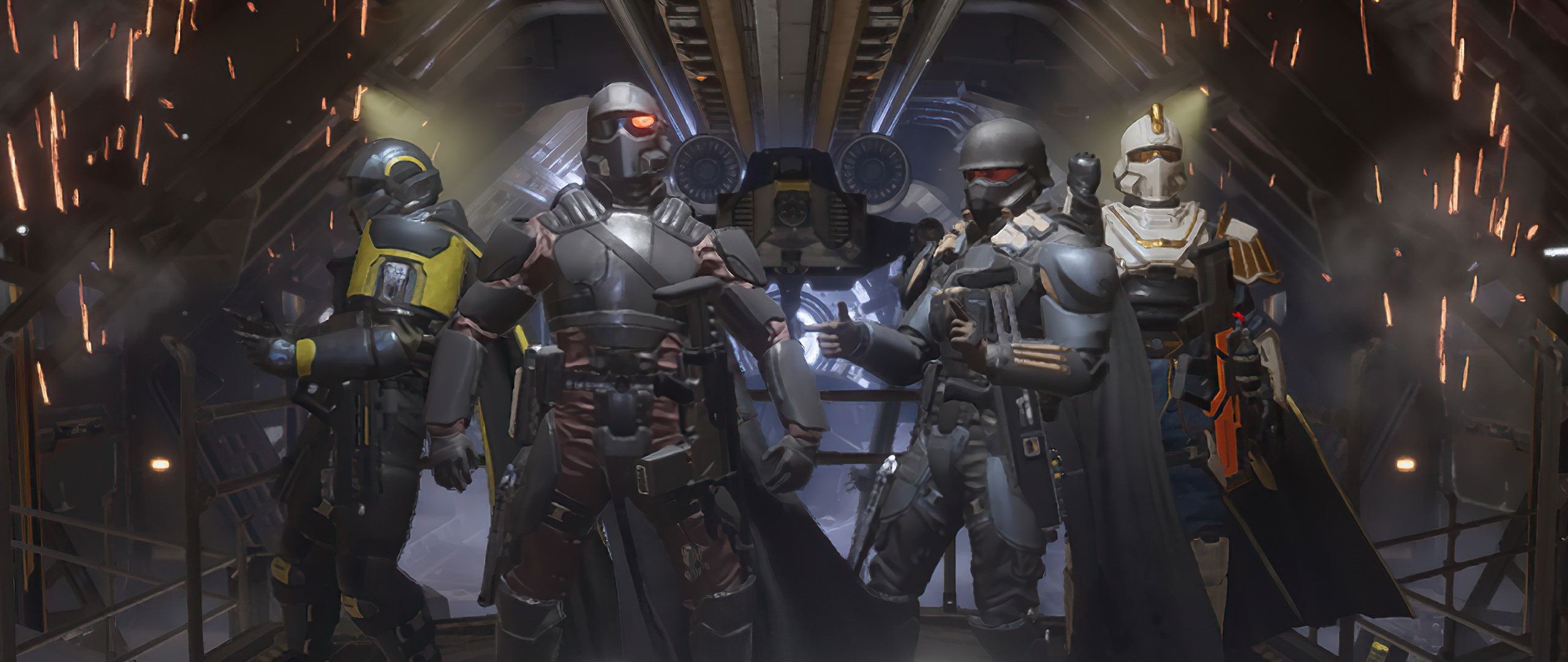
These last few weeks I’ve been knee-deep in Terminid entrails in my very own bid to spread managed democracy to the furthest reaches of the galaxy. What have you been doing with your life, citizen?
The release of “Helldivers 2” might have resulted in a shock success to some. However, as a veteran of the series, I can tell you that I’m not at all surprised to see Arrowhead Games Studios’ democracy simulator enthrall the masses with its excessive gun-toting, starship-trooping, and low-orbit-nuking gameplay.
This satirical slice of spacefaring American exceptionalism is no one-note joke, however. Underneath its irreverence is one of the most chaotically fun co-op games released in years, paired with a live service experience that isn’t designed to nickel and dime you for cosmetics and pay-to-win assets, but instead to keep you invested in an unfolding galactic war exploding in conflict from both (and potentially more in future) flanks.
I’ve been doing my part for Super Earth. Would you like to know more?
Gameplay
“Helldivers 2” is a squad-based, four-player co-op PvE shoot ‘em up that sees you playing a small but vital role in the ever-churning meat grinder that is the galactic war against Super Earth’s alien enemies. It’s a “Starship Troopers” game in all but name, and while that franchise has its own titles, the Helldivers developers seem to ‘get’ Paul Veerhoeven’s cult classic movie (and to some extent the novel that inspired it) in a way few others have been able to showcase.
It’s a “Starship Troopers” game in all but name.
Helldivers takes an over-the-top, in-your-face, action blockbuster approach to its world, gameplay, and atmosphere resulting in a highly engaging game that can eat away at hours of your evening in what feels like the blink of an eye.
The typical gameplay loop resembles hanging out in your Super Ship, with other liberty-minded Super Citizens as you unlock and outfit yourselves with a super arsenal of weaponry before customizing your Helldiver to look super-cool, and climbing into a super-sized bullet and being fired into the surface of a nearby occupied planet at super-sonic speeds to dish out ever-increasing levels of excessive and wanton destruction.

The biggest change-up in gameplay with “Helldivers 2” is the shift in perspective. No, Super Earth hasn’t decided to give Super Communism a try, but the game has made the leap from isometric twin-stick shooter to full-on third-person blast 'em-up.
Coming off of the back of the original “Helldivers,” this wasn’t something I was entirely sold on from the trailers, as I loved the thrill of roleplaying as an elite, yet expendable, short-sighted Terminid exterminator of intergalactic freedom.
In the original game, your vision cone was so shallow that I was amazed by how the competent and legitimate stratocratic government of Super Earth ever allowed my little avatar of liberty to climb into the cockpit of a Mk3 TD-110 Bastion mobile tank destroyer, let alone proceed to use it to indiscriminately pulverize anything and everything heading my way — friend and foe alike.
But my Helldiver’s myopia only added to the excitement, as it was incredibly easy to become swarmed from all directions by foes of the federation, leading to all kinds of bug-and-bot hijinx and the type of emergent gameplay that EA would attempt to market and monetize as a “Battlefield Moment.”
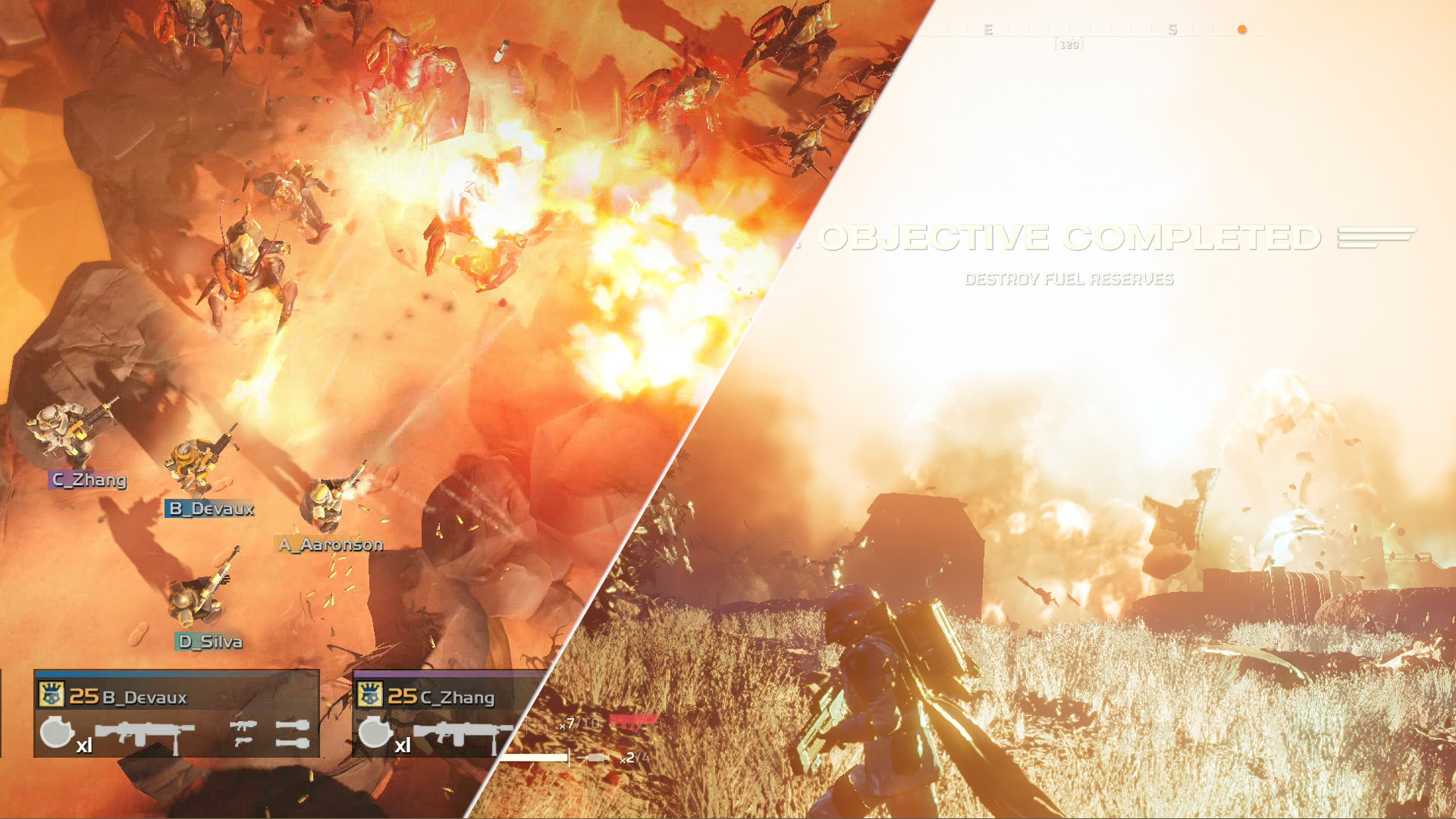
Thankfully, having now played “Helldivers 2” my fears have been put to rest. Yes, you can see the Terminid and Automaton scourge from much further away now, and yes, once you’ve hell-dove your way down to the surface of a planet you can plan your movements to avoid conflict.
Run-and-gun-gameplay with brief interludes of “Dance Dance Revolution”
But as I quickly realized, taking two steps in the opposite direction of a Terminid swarm after spotting them from a ridge in my first mission, why on Super Earth would you want to? There’s a word for that, citizen: Cowardice.
“Helldivers 2” isn’t a tactical shooter where stealth is rewarded, it’s a four-player co-op blitz on the senses that wants you to spread as much democracy via the business end of the glowing white hot barrel of an AR-23 Liberator as humanly possible.
Absolute carnage is seemingly the true name of the game, as you’ll be intermixing your run-and-gun-gameplay with brief interludes of “Dance Dance Revolution” as you quickly input button prompts to register support requests from your Super Ship by way of Stratagems — summonable equipment including player revives, weapons, supplies, turrets, drones, mines, or everybody’s favorite: laughably high-powered orbital ordinance designed to raze the ground where you throw your targeting beacon, and just about everything stood on top of it.
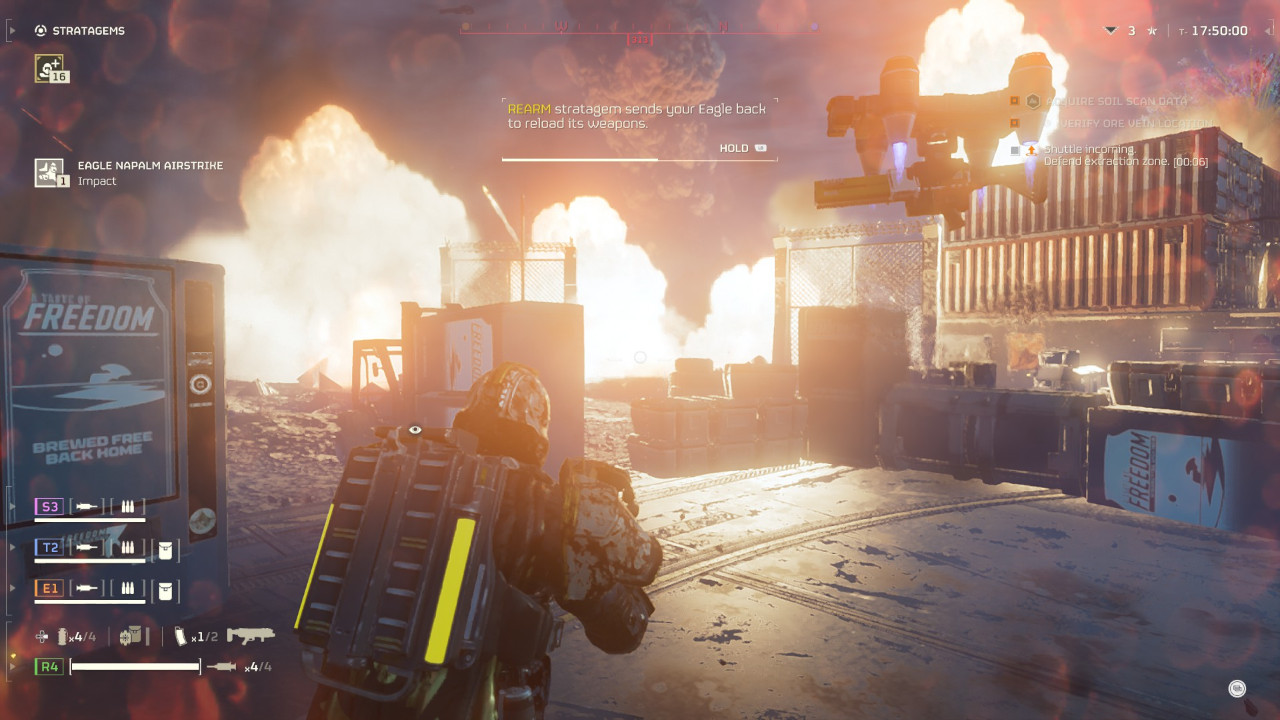
There’s something deeply satisfying about dropping enough explosives to level a small village onto a five-story tall bug, something that’s honestly hard to put into words. The same can be said about the reaction you’ll have when realizing you should’ve been standing at least 50 meters further back from that explosion, as your Helldiving existence flashes before your eyes while you’re Fus Roh Dah’d halfway across the map.
Your Helldiving existence flashes before your eyes while you’re Fus Roh Dah’d halfway across the map.
Luckily, death isn’t the end for your Helldiver. Kick the bucket on a mission and your squad mates can use a Stratagem to call you back into the fight, summoning you from your Super Ship, raining onto the battlefield in your bullet-shaped “Hell” pod — shaped as such for more than simple aerodynamics as you can pilot your pod straight through enemies below, pulverizing them before you even spawn back into the action.
The mission isn’t ever truly over until every last bug or bot has been eradicated from the randomly generated sandbox areas found at the end of each orbital drop. Well, for me, anyway. For most, exploring for resources and completing the various objectives and side-missions you’re dished out is enough, with each mission ending in a tense fight for survival as you wait for pickup — though, you’ll be handsomely rewarded for your efforts with XP, Requisition Slips, Medals, Samples, and Super Credits.
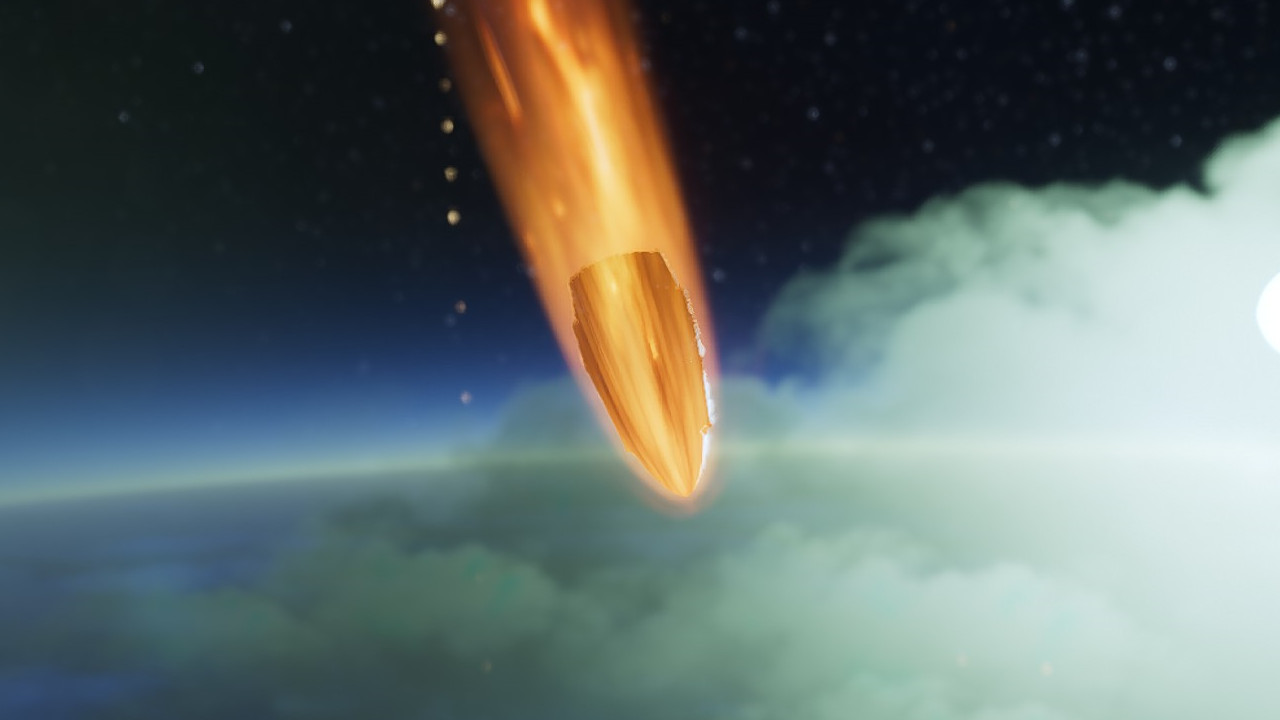
XP levels up your Helldiver’s rank, with more powerful support Stratagems available the more said rank increases; Requisition Slips are used to unlock Stratagems, making them available to take with you on missions; Medals unlock content from the game’s battle passes (known as War Bonds) and are rewarded to Helldivers at the end of missions with the amount determined by mission difficulty; Samples are easily found in most missions and can be used to upgrade your Super Ship between missions; and Super Credits are a premium currency used to buy cosmetics and weapons from the game's store.
Live service games have a bit of a bad rap due to some bad actors, and their fondness for stretching out thin strands of content to their monetarily profitable maximum while raking you over the coals for every last red cent you own. Helldivers is a live service game, too. Though, it’s a live service game done right.
A title that feels far more play-to-win, than pay-to-win.
It makes sense for this game to routinely be updated, drip-fed content, and include additional progression pathways like battle passes. The liberation of a planet can take days to complete with thousands of ‘Divers all zipping down to the surface to work towards a collective goal. It’s only reasonable to assume that over time the galaxy adjusts to compensate for this mass effort, countering the player base’s moves with new scenarios, mission types, and threats.
Where “Helldivers 2” differs from other live service games, is that everything here can be earned or found in missions, including the premium Super Credits currency. Resulting in a game where a character's rank likely dictates their overall potential for absolute carnage, all of it well-earned through numerous incursions. You can purchase premium currency, and therefore give yourself a leg-up on certain battle passes, but you’ll earn your fair share of that currency through gameplay alone, resulting in a title that feels far more play-to-win, than pay-to-win.
Story
“Helldivers 2” takes place a century after the victory over the Terminid, Cyborg, and Illuminate factions of the original game. Since then Super Earth has enjoyed an era of peace, prosperity, and galactic colonization. But galactic democratization takes a lot of resources, and Super Earth has become reliant on the E-710 energy source produced by decomposing Terminid bodies. So, naturally, they’ve resorted to farming the bugs on an industrial scale.
Showing their opposition to liberty, the Terminids have since overthrown their hard-working, oil farmers and begun spreading throughout the east of the known galaxy. While Super Earth’s Armed Forces are busy holding the bug plague back, a strange new threat moves in from the west — the Automatons, an eerie Cyborg-like faction threatening the safety of our democracy.
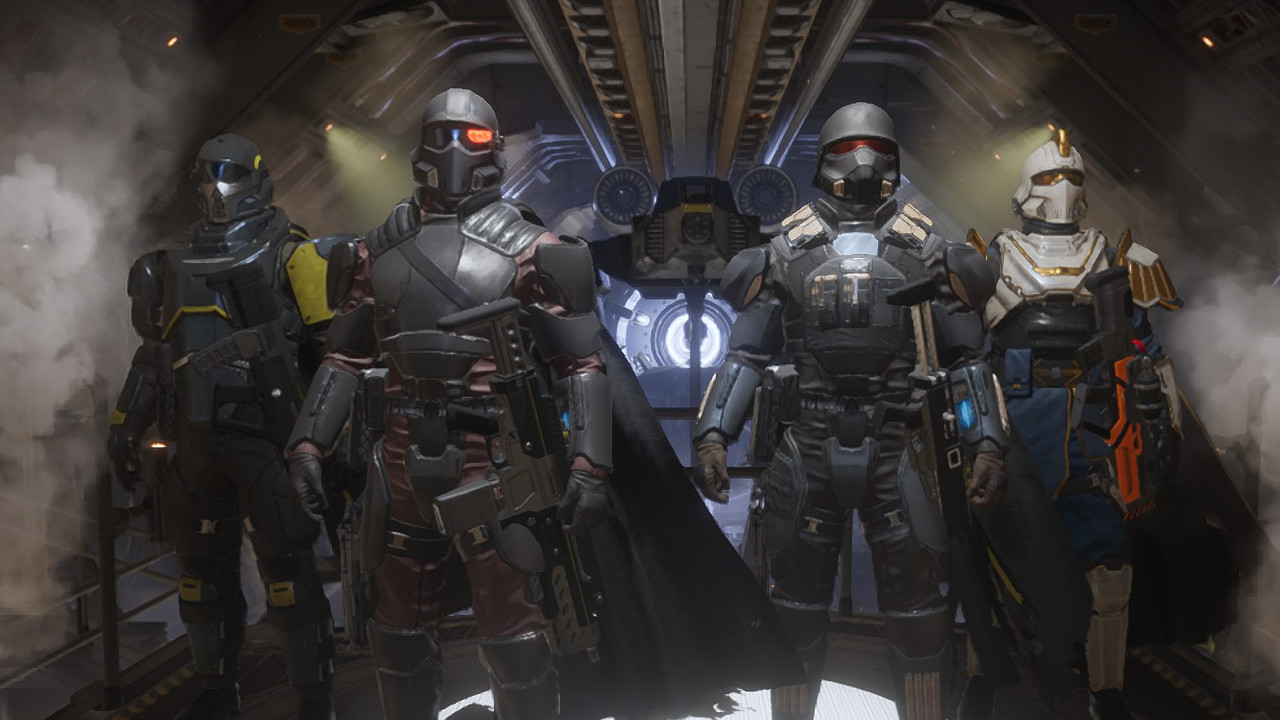
Hans, are we the baddies?
That’s where you come in, citizen. The Helldivers have been mobilized once more, and it’s your turn to do your part by saving Super Earth colonies and securing her way of life. Your story starts with a simple training course, where you’re indoctrinated introduced to the core gameplay mechanics of traversal, combat, calling in Stratagems, and dealing with the Terminid threat.
This is your initiation into becoming a Helldiver, at the end of which you’re graced with the crowning jewel of any self-respecting, spacefaring, savior of Super Earth, your Helldiving cape: An iconic status symbol depicting you as a true citizen to the federation, a sign that you’re doing your part, and a symbol of your heroism.
Only heroes wear capes, after all. Everyone knows that. Magneto, Dr. Doom, M. Bison… Hmm.. Only heroes wear capes and fly around the galaxy in their Super Ship bombarding alien planets from above with incredibly high-powered weaponry. Everyone knows that. Just like… Darth Vader…
Hans, are we the baddies?
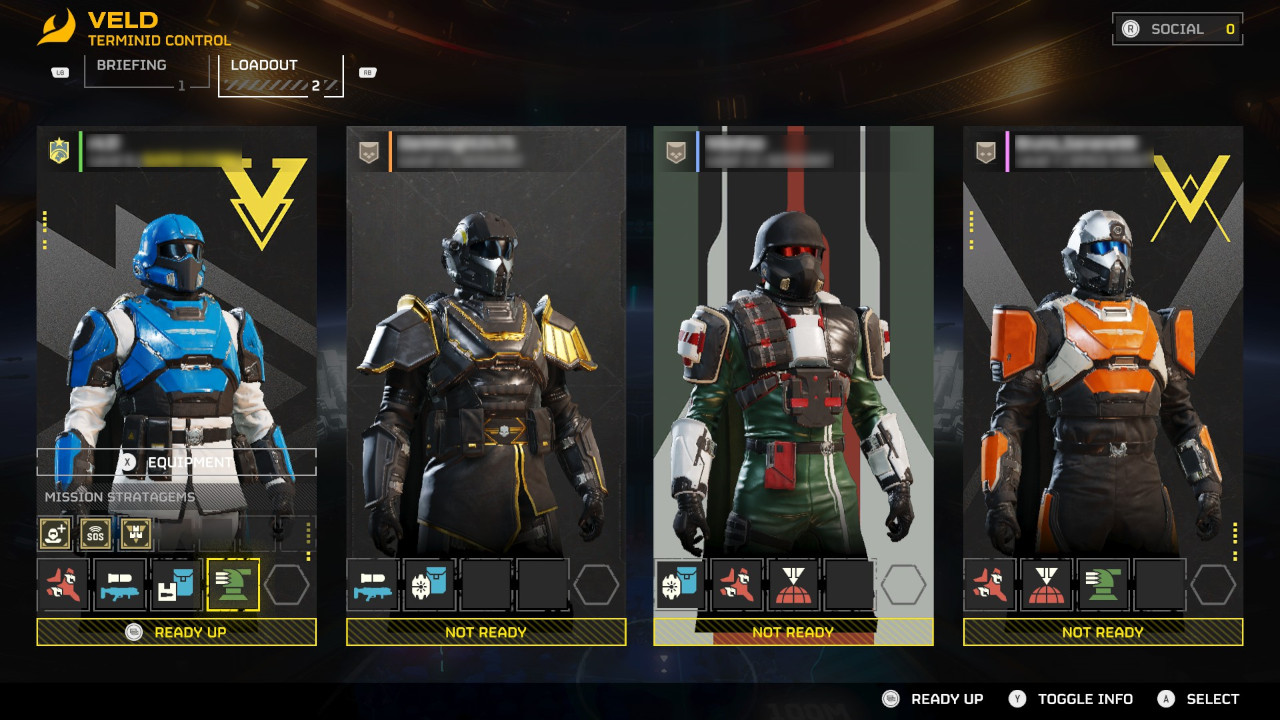
The real story is the carnage you leave in your wake, the hero of democracy you’re willing to risk your life to be, and the moments of sheer brilliance to be found in the wider cooperative experiences as thousands of players work together to liberate planets and push the evolving story forwards. Yes, I said it, maybe the real magic was the Helldivers we team-killed with nukes along the way.
As a live service game, the Helldivers universe promises to bring more to the table over time, including new global events; new biomes, and planets to fight through; new Stratagems featuring powerful weapons and equipment to help tackle evolving threats; and maybe most importantly, the chance to witness how this galactic war unfolds.
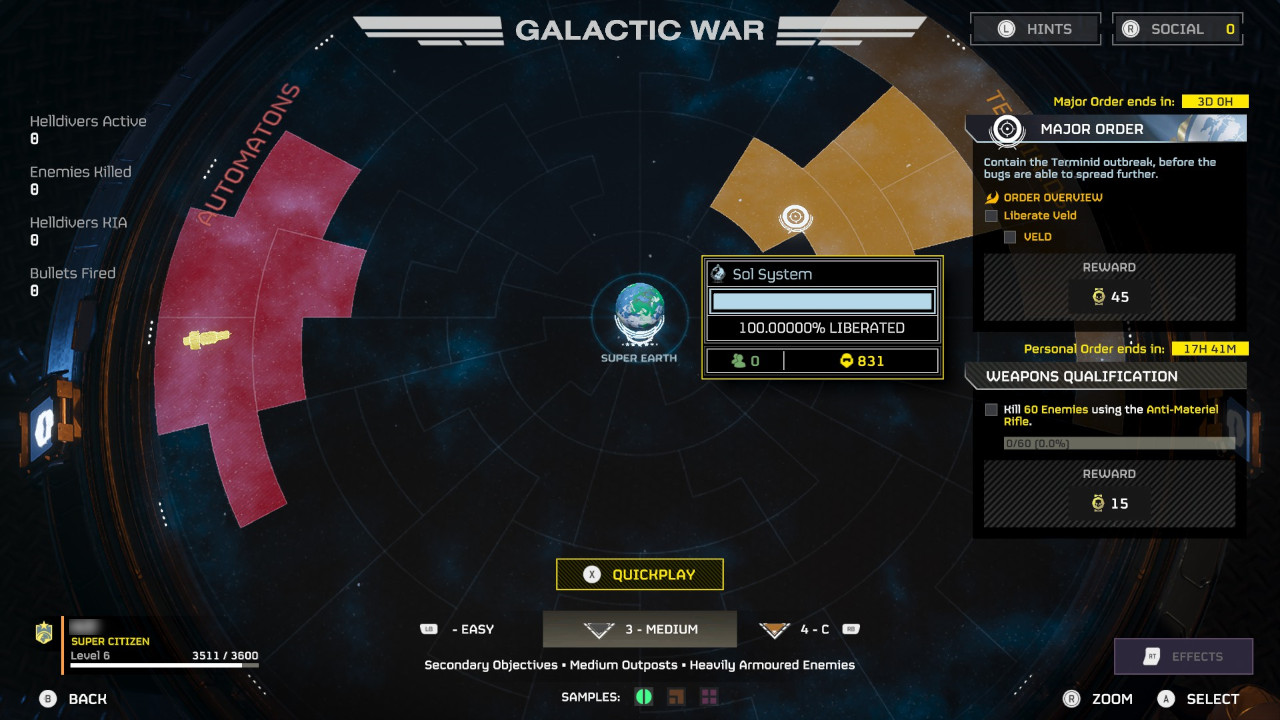
Maybe the real magic was the Helldivers we team-killed with nukes along the way.
Players mainly witness the progress of the war through live-tracked liberation of planets on the galactic map, each mission victory results in a small increase in the percentage of a location being liberated, with 100% liberation allowing players to move forward, pushing further into the enemy territory where the entire process kick starts on new worlds, with new threats, and new tasks.
With the Automatons to the east, and the Terminids to the west, the galactic map has plenty of room for further threats to emerge, with the Illuminates of the first game still mysteriously absent from the current conflict. While they could spring from the south, the north of the galaxy remains eerily quiet and could host an all-new faction for Helldivers to concern themselves with.
Most interestingly, hovering over Super Earth reveals a “Liberated” percentage also, potentially indicating that Helldivers may at some point in the galactic war have to defend their homeworld.
Where any of this goes, nobody but Arrowhead Games Studios knows, but all of the ingredients are there for a pretty compelling skirmish that keeps the game fresh and exciting for some time.
Performance & requirements
Running on an MSI Stealth 17 Studio A13V laptop with an Nvidia GeForce RTX 4060 Mobile GPU, 16GB of RAM, and an Intel Core i7 13700H CPU, Helldivers 2 was a treat across multiple graphics configurations and easily met the title’s minimum specs.
CPU: Intel Core i7-4790K / AMD Ryzen 5 1500X
GPU: Nvidia GeForce GTX 1050 Ti / AMD Radeon RX 470
RAM: 8GB DDR4
Storage: 100GB HDD (7200rpm)
OS: Windows 10 64-bit and up
If you want peak graphical fidelity, my system managed to squeeze out between 30 and 40 frames per second on Ultra settings, 50 to 70 frames per second on high, 80 to 100 frames per second on medium, and 110-120 frames per second on low.
Bear in mind, that these results are from using the default optimization levels while running at 1440p, fine-tweaking preset values and dropping the resolution to 1080p can result in some impressive performance boosts across the board.
The only good bug is a dead bug. Thankfully, the majority of my time with “Helldivers 2” was relatively and ironically bug-free, save for the Terminid horde and an animation glitch that plays when re-boarding Super Ships. There were one or two crashes during release week that I had to contend with, but for much of the last fortnight things have been pretty smooth — when I’ve been able to get online, that is.
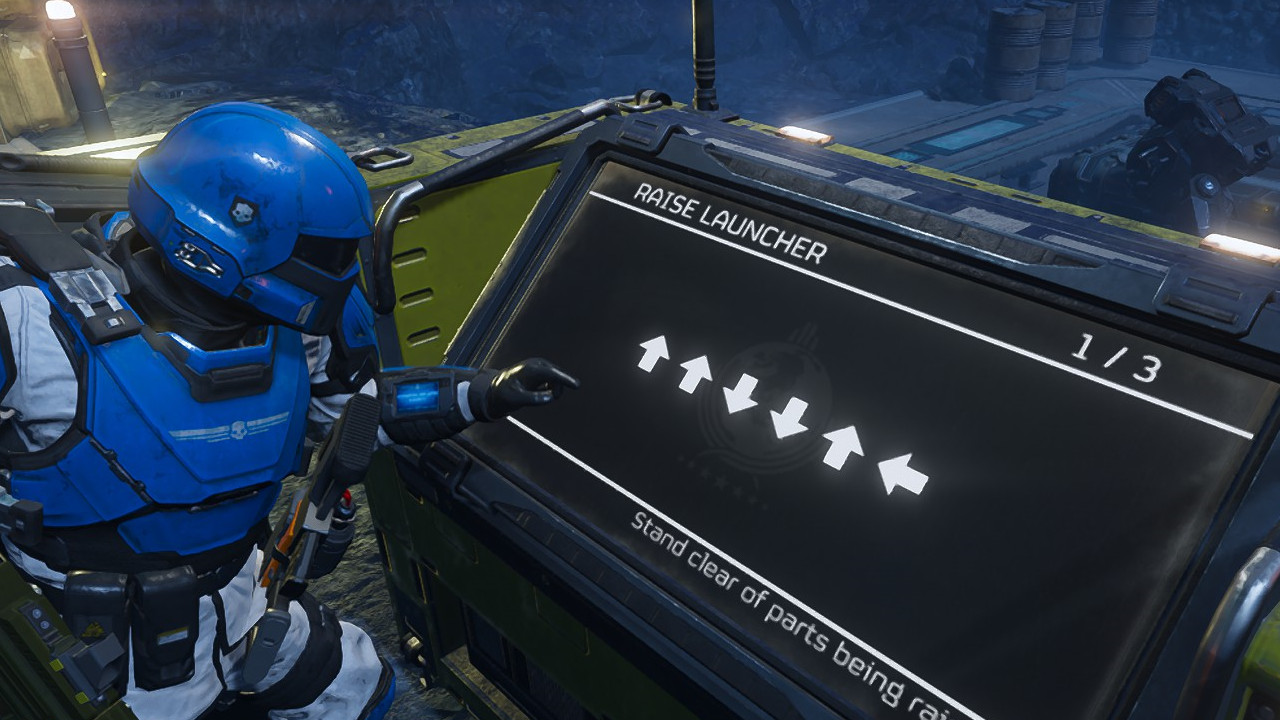
While the original “Helldivers” was a fantastic title, it couldn’t claim to have had a gargantuan player base. As such, when indie game developer Arrowhead Games Studios released “Helldivers 2,” they were expecting a similar level of interest, potentially hoping, as any developer would with a sequel, for a little more.
The majority of my time with “Helldivers 2” was relatively and ironically bug-free.
At the time of writing, “Helldivers 2” is currently on an incredible win streak, after having become publisher Sony’s best PC launch to date and overtaking immensely popular titles like “GTA 5,” “Starfield,” and “Rust” to enter the top 20 most-played (by concurrent player count) Steam games of all time as per SteamDB’s rankings.
For this level of interest in its game, Arrowhead Games Studios were simply not ready.
I’ve been holding off on this review until Arrowhead Games Studios managed to get a handle on the issues with server capacity. Not to give them any preferential treatment, but because I knew from the first few hours that I could do nothing but wholeheartedly recommend this game to just about anyone and everyone.
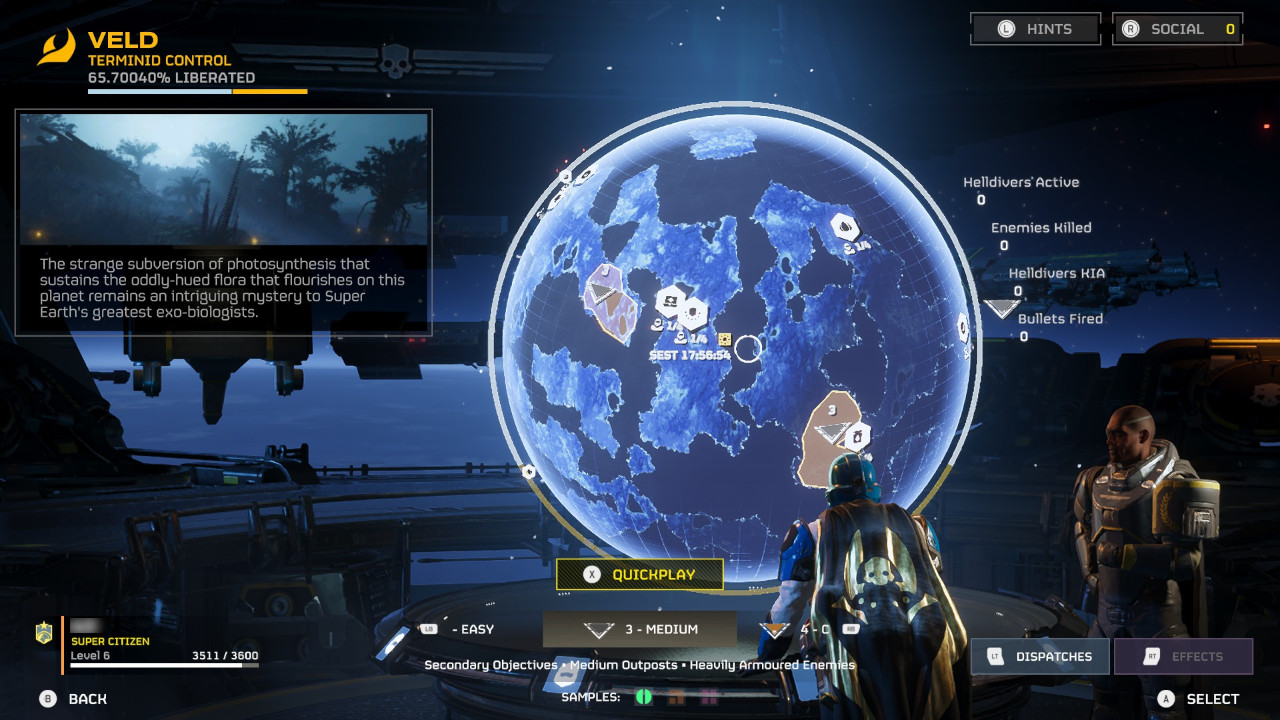
In the event people took that recommendation and ran with it, I’d only have been adding more fuel to the fire that was, at the time, tearing through the impossibly stressed data center housing the “Helldivers 2” servers.
Thankfully, as of 02/28/24, it would appear that Arrowhead Games Studios are making solid progress in expanding server capacity for “Helldivers 2”, allowing more players to join in on the fun and spread of managed democracy throughout the galaxy. Measures have been taken to reduce queue times and increase player limits, and the game is generally running excellently. Though frustratingly, some connection bugs still exist.
Bottom line
For me, “Helldivers 2” is one of the most fun co-op experiences since Valve’s “Left 4 Dead” duology, pairing frantic, fast-paced, and utterly destructive battles alongside a slow and compelling combined push towards community-focused goals.
While missions can last anywhere up to 40 minutes, planets can take days to liberate, but that crawl towards liberation feels somehow rewarding, even if your personal efforts only contribute to a fraction of an overall percentage. The game has scale. Scale worthy of the vast numbers in its community, and with plenty more on tap for future expansion.
Whether you’re looking for a drop-in co-op title to pass the time here and there or your next time sink to play at large, “Helldivers 2” is worth a spot in anyone’s Steam library. It’s fun, frantic, and oftentimes hilarious. While its core gameplay loop can feel slightly repetitive at times, there is a world (many worlds in fact) of variety to be found in its constantly evolving galactic war.
If you have a great time when playing with others, it’s time to enlist. But, if you’re more of a lone wolf on the battlefield, you’ll struggle to enjoy this game to its fullest. Find a friend, or make new ones in-game and do your part to protect Super Earth today.
Well? What are you waiting for? Come on, you apes! You wanta live forever?







